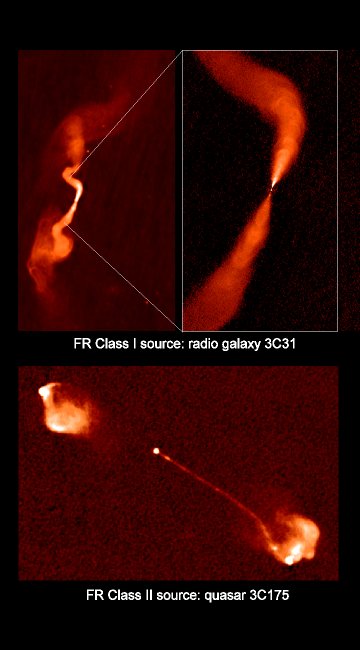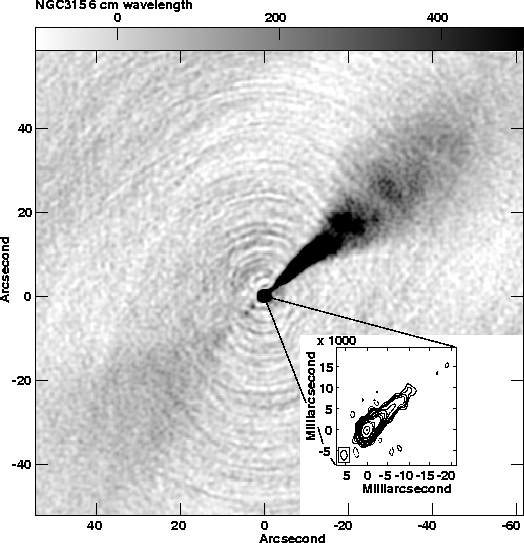


Next: The VLA and internal structures of jets
Up: Impact of the VLA: Physics of AGN Jets
Previous: AGN jets before 1978
The VLA greatly accelerated the study of radio
jets, for several reasons. It had the sensitivity to detect weak jets
with short observations, the dynamic range to do so
in the presence of bright unresolved emission in the galactic nuclei,
and the angular resolution to separate the jets convincingly
from surrounding extended structures. It also allowed
polarization imaging with good sensitivity and resolution, and this
revealed key details of the jets' magnetic configurations.
VLA observations quickly provided examples of jets
in all types of radio-loud AGN.
The detection of radio emission from, or at least
closely associated with, the presumed pathways of energy transport
in continuous-outflow models cemented the case for
these models¹.
Furthermore, numerous correlations between the properties of the jets and
other attributes of the radio sources became apparent. These included:
- Correlations between jet properties and the Fanaroff-Riley
structure classes: The plume-like, low-luminosity, Fanaroff-Riley
Class I sources (Fanaroff & Riley 1974) have
two-sided, rapidly spreading and
prominent jets (e.g., Figure 3). The "classical double",
higher-luminosity, FRII sources have one-sided,
narrowly-collimated jets that are more prominent in quasars than in
radio galaxies (Bridle & Perley 1984).
- Correlations between kiloparsec and parsec scales: The brighter
kiloparsec-scale (VLA) jet is always a plausible extension of the brighter
parsec-scale (VLB) jet. The kiloparsec-scale jets are also well aligned with
the parsec-scale jets in the FRI sources
(Giovannini et al. 1995; Venturi et al. 1994, 1995), as exemplified by NGC315
in Figure 4,
and in lobe-dominated FRII sources. The
angular relationships are more complex in core-dominated sources whose
jets appear more bent, but even in these sources the
brighter large-scale jet is usually a plausible continuation of the
brighter small-scale jet.
- Correlations between jet sidedness and depolarization asymmetry:
In sources whose jets differ greatly in brightness, the
brighter jet is on the side of the source that depolarizes less at long
wavelengths (Laing 1988; Garrington et al. 1988, 1991; Parma et al. 1996).
This is consistent with the brighter jet always being on the nearer side of the
source.
- Correlations between magnetic field orientation and jet sidedness:
well-resolved jets are often highly linearly polarized, so
their magnetic fields are partially ordered -- one-sided jet features
in FRII jets and at the bases of FRI jets are dominated by field components
along the jet axes, but straight FRI jets are dominated by perpendicular
field components further from the AGN (Bridle 1984).

Figure 3:
VLA images of jets in a Fanaroff-Riley Class I source
(3C31: 1.4 GHz, 5.5" FWHM and 8.4 GHz, 0.3" FWHM)
and a Class II source (3C175: 4.9 GHz, 0.35" FWHM).
|

| Figure 4: The correlated sidedness and good alignment of the kiloparsec-scale
and parsec-scale jets in NGC315 (superposition kindly provided by W.D.Cotton).
The gray scale image is from VLA B configuration data at 4885 MHz, the inset
contour plot is from VLBA data at the same frequency. |
Jet modelers now had some clear observational correlations to explain.
Much early debate centered on their implications for
jet velocities. The bending of "head-tail" sources, many of which resolved
into U-shaped twin jets, was modeled as an effect of the relative motion of
the host galaxy and an intracluster medium: their symmetries in the presence
of the bending argued for subrelativistic velocities and moderate Mach numbers
(O'Dea 1985). The excellent collimation of jets in FRII sources
suggested low jet densities and high Mach numbers (Payne & Cohn 1985; Williams 1991).
The brightness asymmetries of FRII jets on
many-kiloparsec scales encouraged the idea that their bulk velocities stay
relativistic, like those of their one-sided and
often superluminally-moving parsec-scale counterparts, even on these large scales.
- 1.
- The
models had their roots in early papers by Morrison (1969), who outlined a
pulsar-like model
for an AGN emitting a continuous relativistic beam, and by Rees (1971), who
suggested that the sources were powered by low-frequency electromagnetic
beams. Longair et al. (1973) argued for an energy
transport time scale "comparable with the age of the source" and Scheuer
(1974) explored the dynamics of radio sources powered by relativistic beams.
Blandford & Rees (1974) suggested a "twin-exhaust" collimation mechanism
for relativistic plasma flows (on 100-pc scales).



Next: The VLA and internal structures of jets
Up: Impact of the VLA: Physics of AGN Jets
Previous: AGN jets before 1978
Alan Bridle
Tue Oct 13 15:58:42 EDT 1998

